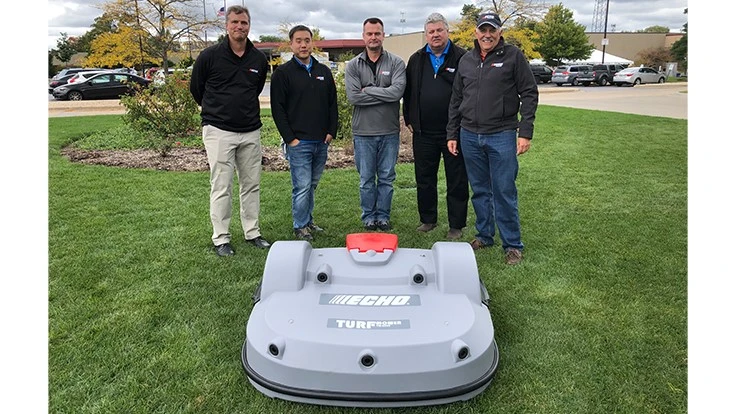
Guy Cipriano
Trimmers, blowers, power washers, generators, spreaders and robots.
ECHO Incorporated introduced a slew of new products during a media preview event Oct. 4 at its Lake Zurich, Illinois, headquarters. The products poised to spark the most interest in the golf market, though, stand out for what they don’t require – an operator.
ECHO, under its ECHO Robotics division, will become the latest company offering autonomous solutions to the North American golf market when it releases the RP-1200 range picker this fall. The RP-1200 joins the TM-2000 autonomous mower, giving ECHO Robotics a duo directed toward helping golf facilities handle the increasing volume of practice range maintenance. The range could offer a gateway to automation for superintendents, a group curious about robotic possibilities yet still leery of implementing operator-free technology on playing surfaces.
Golf Course Industry asked superintendents in its 2019 State of the Industry whether they are utilizing autonomous mowers. None of the 155 superintendents who answered the question indicated they use the technology on their respective courses, although it should be noted a few North American facilities deploy Cub Cadet’s RG3 on greens. A follow-up question asked how likely superintendents are to use autonomous mowers on greens, fairways and rough, with 57 percent answering “never” or “not likely” in all three areas.
The survey was distributed last December and didn’t include a question about the likelihood of using automation on a driving range. Since the release of the survey, the labor crunch affecting golf facilities has intensified. The U.S. unemployment rate dipped to 3.5 percent in October and thousands of superintendents spent significant periods in 2019 without a fully staffed crew. Conversations about robotics in golf and sports turf expanded earlier this year after ECHO Robotics unveiled the TM-2000 at the Sports Turf Managers Association Conference and Expo and John Deere announced an agreement to develop autonomous mowers for both markets with Netherlands-based Precision Makers before the Golf Industry Show.
ECHO Robotics will make its GIS debut in 2020 in Orlando. ECHO handheld products can be found in maintenance facilities across the country, but the RP-1200 is believed to be the company’s first golf-specific product. “It’s definitely exciting and a new adventure for us,” ECHO president Tim Dorsey says.

Vice president of robotics Joe Fahey and national robotics sales manager Jake Vollbeer are among the members of a team responsible for introducing the technology to superintendents and distributors. Demonstrations of the RP-1200 and TM-2000 working in tandem have commenced on select North American courses. Finding early adopters, Vollbeer adds, represents one of the company’s biggest challenge as it wades into a new market.
“Our internal knowledge at ECHO has grown dramatically over the last six months,” Vollbeer says. “It’s a continual educational process. We are trying to come up with different methodologies to educate the end user and the dealer, because things change very quick. The product that we have in front of us today isn’t anything like it was a year ago. It was completely different.”
The RP-1200 and TM-2000 were developed by Belgium-based robotics manufacturer Belrobotics, a company purchased by ECHO’s parent company Yamabaiko. Both products are available to greenkeepers throughout Europe, where automated mowers on sports fields and university grounds are common sights.
“We really believe this is the future,” Fahey says. “This has been proven in Europe. The Europeans are very much in tune with robotics. The number of robotic mowers sold in Europe is about ready to surpass traditional mowers. The market is huge there. North America is starting to figure it out.”
ECHO Robotics officials showed a video at the media preview event describing how Naxhelet Golf Club in Belgium maintains its range. The course’s system is fully automated, meaning balls are collected, cleaned and dispensed without human involvement. The video also illustrated how the TM-2000 works alongside the RP-1200, which holds around 280 balls. The TM-2000 features five blades, with height of cut capabilities ranging from ¾ of an inch to 4 inches. The mower can maintain up to six acres. The current version, Fahey says, doesn’t produce stripes.
“There are tradeoffs,” Fahey adds. “When you start mowing robotically, you are making a commitment to change. We all like stripes. But how about your grass looking like it was just mowed every single day? Would you be willing to have that tradeoff?”
Charging stations power the range picker and mower, and employees can monitor and control units via a mobile device or laptop. Once charged, the RP-1200 and TM-2000 work in a variety of conditions, including at night. Sonars alert the units of obstacles. Creating the infrastructure to operate the units requires installing wiring 2½ to 3 inches below the surface around a range.
“It starts with site selection,” Vollbeer says. “You go to the site and look for areas that we can’t go, like near a certain water feature. We need the right site. It’s then drawing a line in a plan, like an architectural plan … where the wire is going to go, where the power is going to go, how do we get the power there. If the power is available and the site is good, it’s an afternoon to do the install. To do a ball drop can take a little more time depending how in-depth and how complicated you want that ball drop to work.”
Guy Cipriano is GCI’s editor.
Get curated news on YOUR industry.
Enter your email to receive our newsletters.Latest from Golf Course Industry
- SePRO hires new technical specialist
- Plant Fitness adds Florida partner
- LOKSAND opens North American office
- Standard Golf announces new product lineup for 2025
- The Salt Pond taps Troon for management
- KemperSports selected to manage Swansea Country Club
- From the publisher’s pen: Grab that guide
- Introducing our April 2025 issue







